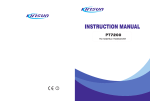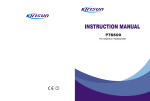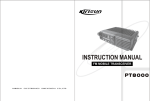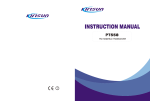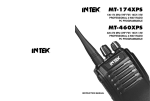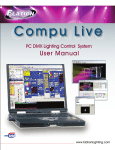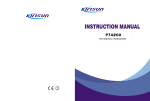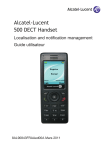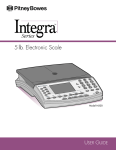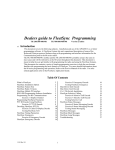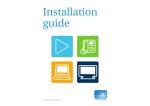Download PT4208 User Manual
Transcript
INSTRUCTION MANUAL PT4208 FM HANDHELD TRANSCEIVER NOTE INSTRUCTION MANUAL PT4208 FM HANDHELD TRANSCEIVER We are very grateful for your purchasing brand twoway radios produced by Kirisun Electronics (Shenzhen) Co., Ltd. We believe two-way radio, which always incorporates the latest technology, can bring great convenience to your life and work; We also believe that the quality and function of twoway radio can meet your demands for reliable communication. PRECAUTIONS Please observe the following precautions to prevent fire, personal injury, and radio damage. Do not operate your radio while taking on fuel, or being charged. Do not expose the radio for a long period to direct sunlight, nor place the radio close to heating appliances. Do not place the radio in excessively dusty areas, humid 22 areas or on unstable surfaces. Do not modify this radio for any reason. Refer service to qualified licensed or certificated technicians only. Notice to the User: Government laws prohibit radio communication without permission in government districts. Illegal operation is subject to punishment by fine and/or imprisonment. Refer service to the well-trained professional technicians only. Safety It is important that the user is aware of and understands hazards common to the operation of any radios. Warning! Turn off your radio before entering any area with a potentially explosive atmosphere (where the air contains gas, dust and smog, etc.), such as while taking on fuel, or while parking at a gasoline service station. Precautions in Use Please comply with the following attentions to avoid fire, bodily injury and damage to the radio. The radio is recommended to transmit for 1 minute and receive for 4 minutes. Long time transmitting or continuous working in high power mode will make the rear side of the radio generate heat. Please don't disassemble or assemble the radio under any circumstances. Please don't expose the radio to direct sunlight for a long time; don't place the radio near any heating devices, either. Please don't put the radio in extremely dusty, moist or dabbling places; don't place it on any unstable surfaces, either. If the radio emits smoke or strange odors, turn it off and remove the battery from the radio and promptly contact your local authorized Kirisun dealer. CONTENTS 1. Package-opened Inspection and Installing......................................2 2. Preparation......................................................................................3 2.1. Charge the battery..................................................................3 2.2. Install/remove the battery........................................................4 2.3. Install the antenna..................................................................5 2.4. Install external speaker/MIC...................................................6 2.5. Install the belt clip....................................................................6 3.Radio Overview................................................................................6 4.Basic Operation................................................................................7 5.Programmable Key Function............................................................8 6.Auxiliary functions..........................................................................10 6.1.Time-out Timer.......................................................................10 6.2.Battery saving........................................................................11 6.3.Low battery alarm............................................................... ...11 6.4.Voice Announcement.............................................................11 6.5. CTCSS / DCS.......................................................................12 6.6.Dual Tone Multi-Frequency (DTMF) coding...........................12 6.7.Talkaround.............................................................................12 6.8.Scan......................................................................................13 6.9. Transmission Begin and Transmission End Signals (PTT ID)...14 6.10.Lone worker.........................................................................15 6.11.Emergency Alarm................................................................15 7.Wired Clone...................................................................................16 8.Trouble Shooting Guide.................................................................16 9.Major Specifications.......................................................................18 1 1. Package-opened Inspection Please check the host in the package and the supplied accessories in the following table before using. Any articles are found lost or damaged, please contact the distributor without delay. Preparation 2.1 Charge the battery Insert the cable of the power adaptor into the adaptor jack at the back of the charger, insert the power adaptor 1.1 Supplied Accessories Accessories Antenna Battery Back Clip Intelligent Charger Switching Power Supply Strap User's Manual 2. into applicable AC power output socket, Quantity 1 1 1 1 1 1 1 the 3 LED lights will flash for about 1 second, the green light will be on constantly when normal. Insert the battery to be charged or the radio in the charger, please switch off the radio before installing it into the charger. Make sure that the terminals of the battery and the charger can contact with each other reliably, when the red LED is on, the char-ging starts. After about 5 hours of charging, the red LED will be out, and the green LED will be on, which indicates that the battery is fully charged. When the green LED is on, you can remove the battery, when the Antenna Switching Power Supply battery reaches its best performance, then you can remove the Battery power adaptor from the AC power output socket. If the yellow LED flashes, that indicates abnormal charging tempe-rature or circuit, and the charger is in the protected status, in which you should not charge the battery compulsorily, please remove the Charger Leather case Strap battery and shut the power of the charger. Note: The battery has not been charged when leaving the factory, please charge the battery before using the radio for the first time. 2 3 Both KB-70A nickel-hydrogen battery and KB-70B Li-polymer batt-ery of the company are applicable to this radio. Press the upper end of the battery After being purchased or before the first charging after being laid down till the push button on the radio aside for a long time (2 months), the battery can reach its normal completely bounce out and locked. capacity after several times of charging, please ensure to charge the battery for at least once every three months. When the battery is fully charged or not used till the low ba ttery alar m Remove the battery status of the radio, it's better not to recharge it so as to avoid To remove the battery, slightly influence its longevity and performance. Please remove the battery press the battery and pull the push from the charger after the charging. button upwards, and then remove If using KB-70A, when the radio enters the low battery alarm status, the battery from the radio. please recharge the battery before reusing it, do not switch on the radio compulsorily, which may influence the longevity and perfor-mance of the battery. KB-70B battery is provided with internal protective circuit, in the low Note: battery status, it will cut the power automatically, if it's charged on Please avoid short circuit of terminals of the battery or throw the battery the charger now, the red LED will not be on immediately, about 1-5 in fire. minutes later, the charging indicators will turn normal. Do not remove the shell of the battery by yourself. 2.2 Install/remove the battery 2.3 Install the Antenna Holding the base of the antenna, screw the Install the battery antenna clockwise into the connector on top Align the two protrusions at the lower of the radio till it's fastened. end of the battery to the slot at the lower part of the shell of the radio and insert in. 4 5 2.4 Install external speaker/MIC Turning to select channels 1-16. Open the soft rubber cover of external speaker or MIC with your finger- .Power/Volume knob -nail, insert the pin of matching external speaker or MIC into the pinhole Turn clockwise to turn on the radio, keep turning to adjust the of the radio. volume.To turn off the radio, just turn the knob anticlockwise till a 2.5 Install the belt clip .PTT (PUSH-TO-TALK) key Align the guide rail of the support of the Press the PTT key and talk towards the MIC to send the voice to the sound of belt clip to the guide slot on the back of the Ka-Da is produced. recipient. battery and push downwards properly; to .Side key 1 (programmable key) remove the belt clip, insert your fingernail or a tool into the slot on the .Side key 2 (programmable key) upper part of the belt clip and push the card upward, at the same time, .Top key (programmable key) push the belt clop upward by force to remove it. .Speaker/MIC connector Connecting external speaker and MIC. 3. Radio Overview 4. Basic Operation . Startup: Turn the Power/Volume knob clockwise to turn on the radio. If the dealer has set the prompt sound, a sound of Bee will be produced. . Volume: .LED INDICATOR Red LED on when transmitting, green LED on when receiving signals. 6 You can press the key programmed to cancel squelch to receive background Red LED flashes when low battery. noise and then turn the Power/Volume key .Channel selector knob to adjust the volume. 7 . Channel: mode. Turn the channel selector knob to select 3.Call Key 1 Sends the DTMF/2Tone code assigned to 4.Call Key 2 Sends the DTMF/2Tone code assigned to the required channel. When the correct signal is received, you can hear sounds from the speaker. . Transmission: call 1 key. call 2 key. 5.Lone worker Press the key programmed as the microphone in the normal voice. Please keep Alarm the microphone about 3 or 4 cm far from your mouth. . Receive: 6.Emergency Alarm The radio will return to the receiving state after you loosen the PTT key. The distributor may have 7.Emergency set the CTCSS/DCS signaling in the programmed Alarm Off radio of your radio. On the channels with CTCSS 8.Mandown Top key, side key 1, side key 2 can be programmed as one of the 0. None 1.Voice Press this key to quit the Emergency Alarm mode. Press this key programmed for Mandown (optional) Start/end the scanning function of system. 10.Nuisance Press this key to delete the noise channel when Delete the radio enales the scan function and stays at the noise channel. Function Description No function Press this programmable key to switch between announcement different languages and modes of voice announ- selector -cement and hear the number of channels being broadcast. 2.Talkaround or background tone to your friend or the 9.Scan following functions. Keys programming software or send your own ID to enter the working mode of mandown radio with the same CTCSS/DCS. 5. Programmable Key Function Emergency to set alarm tone according to the system. /DCS are set, you can only hear the call from other 8 Enables Lone worker function To send a call, press the PTT key and speak to Switch the radio between talkaround and repeater 11.Hi-Low Power Press to switch between high and low power of Switch 12.Monitor momentary the sending power of the radio. Press to disable CTCSS, DCS signaling according to the setting and release to resume normal operation. 13.Monitor Press to disable CTCSS, DCS signaling to receive signals that cannot be heart by normal operation. 9 14.Squelch off momentary 15.Squelch off press again to resume normal operation. b)After the alarm, when the time of transmission exceeds the preset Press to enable squelch and release to resume time, the TOT timer will act. normal operation. 4) TOT reset time: Hold this key to open the squelch. loosen this key a)Limiting the time delay from the PTT key is loosened to the timer to return to the normal operation. resets. b)If the time of releasing the PTT key is shorter than that of the reset, 16.Lone worker reset After enabling the Lone worker, press this key to the countdown continues. reset the Lone worker timer and the timing resumes. 6.2 battery saving The dealer may set the energy saving modes of the battery by 6. Auxiliary functions 6.1 Time-out Time TOT 1) TOT Transmission time limit: a) TOT timer is provided to prevent the talker from talking too long and occupying the channel for a long time, and to avoid too long continu-ous transmission of the radio. b) Setting the time for continuous transmission. When the transmis-sion excesses the preset time limit, the radio will alarm and stop transmission. 2) TOT Rekey time: a) Limiting the time period in which the radio is prohibited to transmit after the TOT timer actions. b) During the period in which the radio is prohibited to transmit, if the PTT key is pressed, a prompt will be generated and the transmission is prohibited. 3) TOT Pre-Alert a)The radio will alarm in advance before the TOT timer pauses the transmission. 10 programming. If this function is enabled, the radio will enter the battery saving mode If not receiving any signal or any operation for 10 seconds. The radio will automatically quit the battery saving mode if receiving any signal or operation. There are 4 modes of battery saving: 1:1, 1:2, 1:4 and off. This function can reduce the power consumption of the battery. 6.3 Low battery alarm In the low battery status, the indicator will flash for prompt. If the battery level is so low as to reach the preset value during transmission of signals, the red indicator will flash. When the battery level is too low, the radio is not capable of transmitting signals. 6.4 Voice announcement This feature can be enabled or disabled by the dealer and has two language modes: Chinese and English. 11 When changing the channel with the channel selector, after the 6.8 Scan channel is changed, the radio will announce the number of the The radio can be programmed to scan multiple channels to channel selected. receive signals from them. 6.8.1 Start/End Scan Function 6.5 CTCSS /DCS a) Press the key programmed to The dealer may have programmed CTCSS or DCS signals on channels of the radio, you can ignore calls of other irrespective radios will stop when signals are found, the radio will stay at the channel using the same channel. with signals till the signals disappear, if the time delay between the When a certain channel is provided with CTCSS or DCS signals, the signals disappear and the scan resumes, the radio will stay at the squelch is only enabled when receiving correct CTCSS or DCS current channel if no signal is received during the dime delay. signals. Similarly, only radios with the CTCSS/DCS signals confo- b) Priority Scan: -rming to that of your radio can receive your signal. You can select one channel in the scan list as the priority channel, Note: Although it appears that once you use CTCSS/DCS, you can which has the highest priority during the scan, during the scan, a ha ve your own channel, if other radios set t he same CTCSS or DCS non-priority channel in the scan list will be scanned first, and then signals, they can still hear your calling. the priority channel, and then the next non-priority channel, and then the priority channel again, and the scan goes on in this cycle. 6.6 Dual Tone Multi-Frequency (DTMF) Coding DTMF signaling can be set into code sequence by the dealer, when the coding template contains DTMF signaling, press corresponding programmable keys Call 1 Call2 , the codes can be when the radio receives signals in a non-priority channel, it is in the Scan Stopped status and will lookback the priority channel in a at the priority channel, if there are no, it will return to the original channel. 6.7 Talkaround In the communication network, you can expand communication range through the repeater, but when the radio is out of the communication range, you can connect with other radio in the talkaround method. Switch the talkaround or repeater mode through If the pr iority channel and the lookback period are set in the Scan l ist, certain cycle, if there are signals in the priority channel, it will stay transmitted. 12 Scan , the Scan function is entered. During the scan, channels in the scan list of the radio Talkaround key. c) There are the following options for the revert channel during the scan set by the dealer (i.e., the transmitting channel during the scan): Select channel: The radio transmits signals from the channel where the scan is started. Selec t channel + current channel: if the radio is at the Scan Stayi ng 13 status, it will transmit signals from the current channel, otherwise, If Transmission End has been set, when you release the PTT switch, it will transmit signals from the channel where the scan is started. the ID signals will be transmitted. Priority channel: The priority channel preset in the Scan list. If both have been set, the ID signals will be transmitted respectively Priority channel+ current channel: if the radio is at the Scan Staying when you press and release the PTT switch. status, it will transmit signals from the current channel, otherwise, it will transmit signals from the priority channel. 6.10 Lone worker Last calling receiving channel: The channel where the radio has If Lone worker is set to be enabled, press the key received signals for the last time. enable the Lone Worker Mode. Start the Lone worker timer and when Last transmission + Current channel: if the radio is at the Scan the preset Lone worker time is reached, the radio will alarm, after the Staying status, it will transmit signals from the current channel, alarm time, the radio will enter the Emergency Alarm Mode and give otherwise, it will transmit signals from the channel where it has out the Emergency Alarm. transmitted signals for the last time. In the Lone worker Mode, press the Lone worker Lone worker to key again to quit the Lone worker mode. 6.8.2 Nuisance Delete If a channel continuously generates noise or interference, press the key to remove this channel from the scan list temporarily. Note: the priority channel can't be removed and the last one in the scan list, either. Quit the Scan mode and enter it again, the deleted channel will be added to the scan list again. 6.9 Transmission Begin and Transmission End Signals (PTT ID) Transmission Begin and transmission End identification signals are used for continuing with or stopping certain repeaters and phone systems. If Transmission Begin has been set, when you press the PTT switch, the ID signals will be transmitted. 14 I n the Lone work er Mode, press the key programmed for reset Lone wo rker (the specific key to select lone worker reset mode) or any key (any key to select lone worker reset mode), the Lone worker timer will start timing again. 6.11 Emergency Alarm Press the key programmed for Emergency Alarm (the time of pressing must be longer than the de-bounce time of the emergency alarm switch) to enter the Emergency Alarm mode. You can set alarm tone according to the programming software or send your own ID or background tone to your friend or the system. In the Emerg ency Alarm Mode, press the key Emergency Alarm Off to q uit the Em ergency Alarm Mode and disable the alarm tone or stop sending it and resume normal operation. 15 7. Wired Clone Mode If the wired clone function is enabled, the radio will not quit after entering the wired clone mode. To return to normal user mode, the user needs to restart the machine. The operating steps go as follows: 1. Press side key 1 for power-on at least 2 seconds and enter the clone mode. If the function is disabled, it will enter the user mode. 2. Connect the slave radio with the wired clone cable first, and then 3 turn on. 3. Press side key 2 on the master radio for starting clone. During transmitting the data, the master radio lightens red, and the slave radio lightens green . After the slave radio receiving all the data, the red light on the master radio is off, and the slave radio restarts. 4. You can keep copying according to step 3 above. 4 8. Trouble Shooting Guide No. Problem 1 Power on Failure 2 16 Solution A. Unreliable connection between the battery and the radio, please reinstall the batter. B. The protective tube of power is burnt out. Please change it. C. Power switch in failure, please change it. D. The rechargeable battery is out of power. Please recharge or change a new one. E. CPU is broken, Please change the IC. A. Channel frequency beyond the range, Phase lock loop unlocked (Beeping) reset channel data. 5 6 B. The crystal X4 of phase lock loop is broken. Please change it. C. The oscillator transistor is broken. Please change it. D. The IC1 of phase lock loop is broken. Please change IC. A. The frequency is not right. Please No talkback reselect the channel of the same fre quency. B. The CTCSS/DCS code is not the same. Please reset it. C. It is out of the effective communication range. A. The antenna is not in good contact. No receiving signal Please fasten the antenna head. B. The high-frequency amplifier Q20 is broken. Please change it. C. The squelch level is set to high, Please reset the squelch level. D. The mixed transistor Q19 is broken. Please change it. E. The IC5 is broken. Please change IC. The red transmission A. Power module Q11 damaged, no power Indicator lights but no output, please change the module. B. MIC damaged, please change it. sound is heard. A. The speaker is broken. Please The green receiving change it. indicator lights but no B. The audio power amplifier Ic8 is broken. sound is heard. Please change IC. 17 9. Major Specifications DECLARATION OF CONFORMITY PT4208 General Specifications Frequency 136~174MHz, V 400~450MHz, U 420~470MHz, U Channel Number 16 Channel Spacing 12.5kHz(N)/25kHz(W) External Dimension (HXWXD) 119mm*54.5mm*34mm Weight 247g (including the battery and the Antenna ) Operating Temperature -25 ~ +55 Receiving sensitivity 0.28 V N 0.25 V W Frequency stability 2.5ppm TX power 4W (UHF) 5W (VHF) Max. frequency deviation 2.5 KHz (N) / 5 KHz (W) Max. audio power 1000mW Power DC7.4V 0678 We, Kirisun Electronics(Shenzhen) Co., Ltd. 6/F, Bldg.H-2,East Industrial Zone Of Overseas Chinese Town,Shenzhen 518053, China Declare on our sole responsibility that this equipment complies with the essential requirements of the Radio and Telecommunication Terminal Equipment Directive,1999/5/EC,and that any applicable Essential Test Suits measurement have been performed. Description of equipment: FM Handheld Transceiver Model No.: PT4208 This compliances is based on conformity with the following harmonised standards or documents: (1). ETSI EN301 489-1 V1.6.1(2004-12) (2). ETSI EN301 489-5 V1.3.1(2002-08) (3). ETSI EN300 086-1 V1.2.1(2001-03) (4). ETSI EN300 086-2 V1.1.1(2001-03) (5). EN60950 2001+A11 2004 Shenzhen, 10 Dec 2008 WenLiang, Fu Place and date of issue General Manager Signature Kirisun Electronics Co., Ltd 18 19 NOTE 20 NOTE 21















